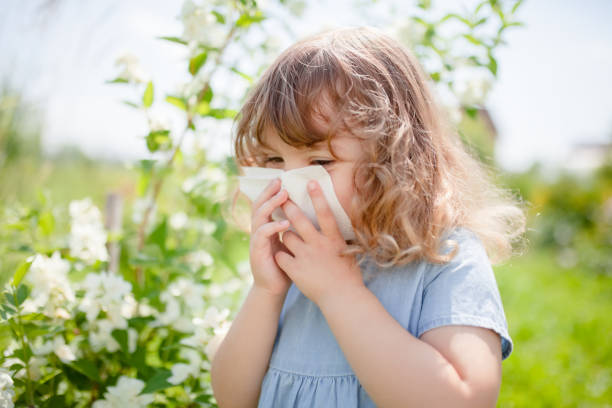Infant Allergies
Everything You Need To Know About Infant Allergies
Infant Allergies Overview
Over the past few years, a considerable increase of infant allergies have been witnessed. About 35% of children get affected by allergies, causing morbidity in them. While allergies can be categorized into environmental, seasonal, and food and medicine, seasonal allergies affect infants during certain parts of the year. Lots of children are allergic to pollen, dust, mold, or pet dander. Children in their first year are seldom allergic to these inhaled substances.

When Do Infant Allergies Develop?
Infants in their first year are highly unlikely to develop seasonal allergies; however, the symptoms can still be developed at any age. Most of the time, kids develop seasonal allergies when they are 3-5 years old. At times, they discover their sensitivity towards allergens when they reach the age of 10. Some children can develop allergies at the age of 1 or 2, but most of the time, they are suffering from indoor allergies caused by dust, mold, or pet dander.
What Causes Infant Allergies?
Children experience the symptoms of seasonal allergies during spring, summer, and fall. The time of allergies can also vary as per your location and the plants surrounding you. When your little one falls victim to one or more of the seasonal allergens, their immune system throws out antibodies that stimulate the release of a protein called histamine to defend against them. The release of this chemical results in allergy symptoms. Here is what causes allergies at different times of the year.
- Spring allergies
This time of the year prevails from March to May and might stretch up to June as well. The common seasonal allergies during this time are caused by tree pollen. Cedar, birch, maple, pine, and oak are some of the major culprits in the act.
- Spring to summer allergies
The time of late spring to summer, typically April to June or July, causes allergies to grass pollen. If your house is surrounded by Bermuda, Orchard, Rye, Brome, or Timothy, your child is very much likely to catch seasonal allergies. If you’re living somewhere in the South of the States, you’ll be suffering from the allergens throughout the year as they pollinate the entire 12 months.
- Summer to fall allergies
This is the time around August to September or October where weed pollen is on the rule. Ragweed is the most common pollen, which is the biggest source of hay fever in children.
Symptoms Of Infant Allergies
If you’ve been listening to a lot of “achoo” noises lately, there is a high likelihood of your child suffering from an allergy. These allergies can develop even if your kid hasn’t had them in the past year. The symptoms of the allergies come up suddenly and stay for as long as your child is exposed to the allergen. These symptoms include:
- Sneezing
- Itchy nose
- Watery eyes
- Dark circles
- Wheezing
- Dry cough
- Irritability
You might also frequently hear complaints about the stuffy nose, headache, shortness of breath, trouble sleeping, and itchy ears. These symptoms can trigger asthma in your child as well. If you notice your child dealing with the same symptoms every year during spring or fall, it is very much possible for your child’s body to be reacting to outdoor allergens. Also, if one of the parents has had a family history of allergies, there’s a high chance of your kid falling victim to them.
How To Differentiate Between Cold And An Allergy In Your Child?
Seasonal allergies affect children of 1-5 school age. Clinical research proves that children with allergies result in significant decrements in cognitive functionality, focus, speed, problem-solving skills, and energy. However, most of the time, allergy is confused with the common cold and is left untreated, leading to detrimental health results. Therefore, it’s essential to be able to distinguish between the two and seek treatment explicitly.
Both cold and allergies can cause sneezing, runny noses, coughing, watery eyes, and headaches, making it difficult to tell them apart. However, certain things can help you alleviate the perplexity. For example, if your child has a wet cough, fever, his eyes look fine, and the color and consistency of his mucus is thick and discolored, then your child is suffering from a cold. On the contrary, if you identify his eyes as watery or itchy, mucus as watery and clear, cough being dry, and no fever, then these are the clear symptoms of an allergy.
There are other ways to differentiate as well, such as:
- Age
Since kids under one are highly victimized to allergies from eczema and food, seasonal allergies are rare to be diagnosed. So, if you are able to identify the symptoms, they either signify cold or are indoor allergens.
- Duration of symptoms
The symptoms of cold are heightened during the first few days and start to fade away gradually. However, if these symptoms carry on for weeks or months, it’s more likely to be a seasonal allergy.
- Family history
If one of the parents has allergies, the chances of your child inheriting them are about twenty-five percent; if both of the parents have allergies, the chances creep up to sixty to seventy percent. First, however, you must get them adequately checked by an allergist to get them diagnosed.
How To Relieve Your Child Of Their Allergy Symptoms?
Allergies are relatively easy to identify as they appear year to year and stay for long; however, keeping them untreated can lead to serious health issues. You must see an allergist to identify the triggers of the allergy and get effective treatment. Meanwhile, certain tips can help you do your part to bring relief to your little one. Try to keep your windows closed at all times to keep the pollen out. Keep your air conditioner on and replace the filters. Limit your outdoor activities to minimize exposure to pollen. Ensure to keep your house clean to keep the allergens from getting trapped in the carpets and filters. Take your shoes off whenever you come home to get rid of the pollen that might have been in them and shower your little one as soon as they come in. Wash their clothes and linen regularly to clear out any possibility of trapped pollen.
Conclusion
Seasonal allergies are common in children; however, you must take all the necessary steps in order to reduce their severity by checking in with a professional allergist and practicing all the tips mentioned above.
Written by: Madiha Ather Hashmi (July 26, 2021)
Sources
- Zave Chad, MD, FRCPC (2001). “Allergies in Children”. Pulsus Group Inc.
https://www.healthline.com/health/allergies/nasal-sprays-for-allergiAllergies in children (nih.gov) - Charles W. Schmidt, (2016). “Pollen Overload: Seasonal Allergies in a Changing Climate”. Environmental Health Perspectives.
Pollen Overload: Seasonal Allergies in a Changing Climate | Environmental Health Perspectives | Vol. 124, No. 4 (nih.gov) - Dave E. Marcotte(2015). “Allergy test: Seasonal allergens and performance in school”. Journal of Health Economics.
Allergy test: Seasonal allergens and performance in school – ScienceDirect
Medically Reviewed By

Alexandria University Hospital
I have reviewed the articles on seasonalallergies.org and I would like to say that I was very surprised.
Over years, I have seen many different articles in the field of allergy, but these articles were very interesting.
These articles were really unique, they could help many people around the world to know more about seasonal allergy, symptoms, prevention and when to seek medical advice.
These articles represent an addition in the field of Health Education not only for people with allergy but also for the whole population.
Looking to learn more about allergy lifestyles? Find a full list of living with allergies resources here.
Last Updated on July 5, 2023